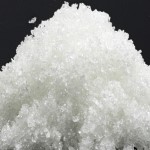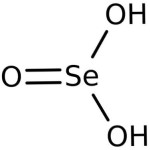CAS Number 7783-00-8, Selenious Acid USP Food Grade Manufacturers Exporters







CAS Number 7783-00-8, Selenious Acid Manufacturer Exporter
For Properties Specifications of Selenious Acid Click Properties, Specifications of Selenious Acid Manufacturer.
For Uses of Selenious Acid Click Uses of Selenious Acid Manufacturer.
For For SDS MSDS Sheet of Selenious Acid Click SDS Safety Data Sheet MSDS Sheet of Selenious Acid Manufacturer.
The Properties and Specifications of Selenious Acid:
Appearance: White hygroscopic crystals.
Melting point: 70C decomposes.
Relative density: around 3
Solubility: Soluble in watter and ethanol.
Specifications of Selenious Acid USP Grade:
H2SeO3 --- 128.97
Selenium dioxide, monohydrated;
Selenious acid CAS 7783-00-8
DEFINITION
Selenious Acid contains NLT 93.0% and NMT 101.0% of H2SeO3.
IDENTIFICATION
A.
Sample: 50 mg
Analysis: Dissolve the Sample in 5 mL of water. Add 100 mg of sodium bicarbonate, and mix.
Acceptance criteria: Gas bubbles develop.
B.
Sample: 50 mg.
Analysis: Dissolve the Sample in 5 mL of 0.1 N hydrochloric acid. Add 50 mg of stannous chloride.
Acceptance criteria: A curdy tan-orange precipitate is formed.
Sample: 10 g
Acceptance criteria: NMT 1.0 mg (0.01%)
Insoluble Matter:
Sample: 1 g.
Analysis: Dissolve the Sample in 5 mL of water.
Acceptance criteria: It dissolves completely, and the solution is clear.
Selenate and Sulfate:
Sample solution: Dissolve 0.5 g in 10 mL of water.
Analysis: Add 0.1 mL of hydrochloric acid and 1 mL of barium chloride TS to the Sample solution, and mix.
Acceptance criteria: No turbidity or precipitate is formed in 10 min.
The Uses of Selenious Acid:
The major use is in protecting and changing the color of steel, especially steel parts on firearms. Another use for selenious acid is the chemical darkening and patination of copper, brass and bronze, producing a rich dark brown color that can be further enhanced with mechanical abrasion. It is used in organic synthesis as an oxidizing agent. Selenious acid is a key component of the Mecke reagent used for drug checking. Selenious acid can supply the trace element indicated in people as a source of selenium.The MSDS-SDS Hazard Statement of Selenious Acid:
Selenious acid SDS, Safety Data Sheet
MSDS 13-Mar-22
Section 1. Product Information
Product Name & Other Names: Selenious acid or Selenous acid
CAS No.: 7783-00-8
EINECS EC Number: 231-974-7
Relevant uses and uses advised against (if any): Industrial Manufacturing.
Suppliers: As per letterhead.
Section 2: Hazards Identification
GHS, Globally Harmonized System Classification in accordance with 29 CFR 1910
Classification according to Regulation (EC) No 1272/2008
Acute toxicity, Oral (Category 3), H301
Acute toxicity, Inhalation (Category 3), H331
Specific target organ toxicity - repeated exposure (Category 2), H373
Chronic aquatic toxicity (Category 1), H410
Labelling according to GHS & Regulation (EC) No 1272/2008
GHS Label Elements  Aquatic Toxicity |
GHS Label Elements |
GHS Label Elements |
Signal Words: Danger
Hazard statements:
H301 Toxic if swallowed.
H331: Toxic if inhaled.
H373: May cause damage to organs through prolonged or repeated exposure.
H410 Very toxic to aquatic life with long lasting effects.
Precautionary statements:
P260: Do not breathe dust/fume/gas/mist/vapors/spray.
P264: Wash … thoroughly after handling.
P270: Do not eat, drink or smoke when using this product.
P271: Use only outdoors or in a well-ventilated area.
P273: Avoid release to the environment.
P280: Wear protective gloves/protective clothing/eye protection/face protection.
P314: Get medical advice/attention if you feel unwell.
P330: Rinse mouth.
P301+310: IF SWALLOWED: Immediately call a POISON CENTER or doctor/physician.
P304+340: IF INHALED: Remove victim to fresh air and keep at rest in a position comfortable for breathing.
Section 3: Composition and Information on Ingredients
Product Name & Other Names: Selenious acid or Selenous acid
CAS No.: 7783-00-8
EINECS EC Number: 231-974-7
Section 4. First Aid & Procedure
Always get medical attention after the first aid is over.
Ingestion: Induce vomiting immediately as directed by medical personnel. Never give anything by mouth to an unconscious person. Get medical attention.
Skin: Immediately flush skin with plenty of water for at least 15 minutes. Remove and wash contaminated clothing and shoes before reuse. Get medical attention if irritation develops.
Eyes: Immediately flush eyes with plenty of water for 15 minutes, occasionally lifting upper and lower eyelids. Hold eyelids apart during irrigation. Get medical attention.
Inhalation: Remove person to fresh air. If breathing is difficult, give oxygen. If not breathing administer artificial respiration. Get medical attention.
Section 5. Fire Fighting Measures
Flash Point: N/A
Extinguishing Medium: Water spray, alcohol-resistant foam, dry chemical or carbon dioxide.
Fire Fighting Instructions: Use suitable protective equipment for surrounding fire.
Extinguishing Media Not recommended: Avoid using solid water jet as it may scatter the fire.
Special Information: In the event of a fire, wear full protective clothing and NIOSH-approved self-contained breathing apparatus with full face piece operated in the pressure demand or other positive pressure mode. At elevated temperatures under fire conditions, it may produce toxic or irritating fumes. Fire-extinguishing work is done from the windward and the suitable fire-extinguishing method according to the surrounding situation is used. Uninvolved persons should evacuate to a safe place.
Section 6. Spills and Disposals
Personal precautions, protective equipment, and emergency procedures: Avoid breathing dust/fumes/gas/mist/vapors/spray. Use individual protective equipment (waterproof boots, suitable protective clothing, safety glasses, etc.). Do not approach facing the wind.
Environmental precautions: Do not let the product enter drains, soil, or water sources.
Methods and materials used for containment cleanup procedures and Storage: Do not inhale vapors, mist, or gas. Avoid dust formation. Contain spilled material. Cover with an inert, non-combustible absorbent material, (e.g., sand, earth, diatomaceous earth, vermiculite). Use a shovel to put the material into a convenient waste disposal container. Finish cleaning by spreading water on the contaminated surface and allow to evacuate as per law.
Section 7. Handling and Storage
Precautions for safe handling: Apply according to good manufacturing and industrial hygiene practices. Avoid prolonged or repeated exposure. Ensure proper ventilation. In case of insufficient ventilation, wear suitable respiratory equipment. Wash thoroughly after handling. Do not drink, eat, or smoke while handling. Avoid contact with skin, eyes, and clothing. Minimize dust generation. Avoid breathing dust/fumes/gas/mist/vapors/spray. Use individual protective equipment (waterproof boots, suitable protective clothing, safety glasses, etc.).
Conditions for safe storage, including any incompatibilities: Store in cool, dry, and ventilated area away from heat sources and protected from sunlight in tightly closed original container. Keep air contact to a minimum. Store protected from heat, sparks and ignition sources and incompatible materials. Do not store with incompatible materials like strong oxidizing agents, organic materials, powdered metals.
Section 8. Exposure Controls & Personal Protection
Exposure Limits for Selenious acid:
OSHA PEL: 0.2 mg/COM Ceiling for Selenium compounds (as Se).
ACGIH TLV: 0.2 mg/CBM (TWA) Selenium compounds (as Se).
Engineering Controls: Use adequate exhaust ventilation to keep airborne concentrations below the allowable exposure limit.
Ventilation System: A system of local and/or general exhaust is recommended to keep employee exposures as low as possible.
Personal Respirators (NIOSH Approved): For conditions of use where exposure to dust or mist is apparent and engineering controls are not feasible, a particulate respirator may be worn.
Skin Protection: Wear protective gloves and clean body-covering clothing.
Eye Protection: Use chemical safety goggles and/or full-face shield where dusting or splashing of solutions is possible. Maintain eye wash fountain and quick-drench facilities in work area.
Other Control Measures: Maintain good housekeeping in work area. Handle in accordance with good industrial hygiene and safety practice. Wash hands after handling.
Section 9. Physical & Chemical Data
Appearance: Selenious acid is solid.
Odor: No data found.
Odor threshold: No data found.
pH: No data found.
Relative density: around 3
Melting Point: 70C
Initial boiling point and boiling range: No data found.
Flash point: No data found.
Auto-ignition temperature: No data found.
Decomposition temperature: No data found.
Upper/lower flammability or explosive limits: No data found.
Vapor pressure: No data found.
Vapor density: No data found.
Evaporation rate: No data found.
Flammability (solid, gas): No data found.
Partition coefficient: n-octanol/water: No data found.
Solubility: Easily soluble in water, insoluble in ethanol
Viscosity: No data found.
Chemical Formula: H2SeO3
Molecular Weight: 128.97
Section 10. Stability and Reactivity
Chemical Stability: Stable under normal temperatures and pressures.
Incompatibility (Materials to Avoid): Strong reducing agents, Organic materials, Powdered metals.
Conditions to Avoid: Incompatible materials, exposure to moist air or water, excessive heat.
Hazardous Decomposition Products: selenium Oxide and fumes.
Hazardous Polymerization: Will not occur.
Section 11. Toxicological Information
Toxicity to Animals: LD50 Intravenous - mouse - 11 mg/kg. LD50 Dermal 4 mg/kg (Rabbit). LD50 (oral, rat) value of 68.1 mg/kg
Carcinogenicity: Not listed as a suspected/confirmed carcinogen by ACGIH, IARC, NTP, SHA.
Teratogenic Effects: Not available.
Mutagenic Effects: Possible for humans. Laboratory experiments have shown mutagenic effects.
Developmental Toxicity: Not available.
Reproductive Effects: No data found.
Specific target organ toxicity: repeated exposure: May cause damage to organs through prolonged or repeated exposure.
Section 12. Ecological Information
Ecotoxicity: Very toxic to aquatic organisms, may cause long-term adverse effects in the aquatic environment.
Results of PBT and vPvB Assessment: No data found.
Persistence and Degradability: Soluble in water. Persistence is unlikely.
Mobility: Likely to be mobile due to water solubility.
Bioaccumulation/ Accumulation: No data found.
Results of PBT and vPvB assessment: No data found.
Section 13. Disposal Suggestions
Dispose of in accordance with all applicable local, state, and federal regulations at an approved waste disposal facility.
Section 14. Transport and Label Information
DOT USA, TDG Canada & ADR/RID Europe:
UN-No UN3283
Proper Shipping Name SELENIUM COMPOUND, N.O.S
Proper technical name: Selenous acid
Hazard Class 6.1
Packing Group III
IMDG/IMO
UN-No UN3283
Proper Shipping Name SELENIUM COMPOUND, N.O.S
Hazard Class 6.1
Packing Group III
IATA:
UN-No UN3283
Proper Shipping Name SELENIUM COMPOUND, N.O.S
Hazard Class 6.1
Packing Group III.
Section 15. Regulatory Information
USA:
California Proposition 65: Not listed.
SARA 311/312: See section 2.
Section 16. Other Information
European Labeling in Accordance with EC Directives:
H301 + H331 = Toxic if swallowed or if inhaled
H373 = May cause damage to organs through prolonged or repeated exposure.
H400 = Very toxic to aquatic life.
Classification according to EU Directives 67/548/EEC or 1999/45/EC:
Hazard Symbols:
N = Dangerous for the environment
T = Toxic
Risk Phrases:
R23/25 = Toxic by inhalation and if swallowed.
R48 Danger of severe damage to health by prolonged exposure.
R50 = Very toxic to aquatic organisms.
Anmol Chemicals & Pharmaceuticals Pvt. Ltd. is an off-shoot of Anmol Chemicals Taloja. It is located in MIDC Taloja and it is manufacturing pharmaceutical grades of API, Excepients, Food grade and Reagent grade chemicals. Anmol Chemicals & Pharmaceuticals Pvt. Ltd. is a several decades old group of companies, engaged in manufacturing, supplying, distributing, wholesale supplies for actual users, retail or small pack supplies for research and development chemicals, fine and speciality chemicals, pharmaceutical excipients, mineral fortifiers in chemically pure, Analytical reagent grade, IP BP USP Ph Eur EP JP and other pharmaceutical grade monograph including FCC Food grade chemicals and Nutraceuticals, Mineral Fortifiers at best prices.

Selenious Acid
Structure
CAS Number 7783-00-8, Selenious Acid Manufacturer Exporter
ANMOL CHEMICALS & PHARMACEUTICALS Pvt. Ltd.
India, USA, Europe, UAE
TELEPHONE: +912223770100
Navi Mumbai, INDIA
e-mail: info(At the rate i.e. @)anmol.org
Copyright. 24-nov-24
We manufacture:



